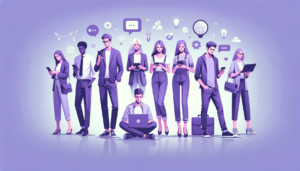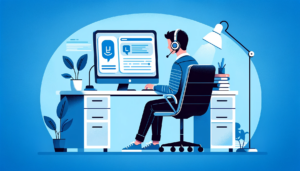Investing in employee growth: Personalized learning for business success
- 5 Min Read
Personalized learning fills a need for both employers and employees. When companies make an investment in the long-term growth of their staff, not only do they address both current and future business needs, but they build loyalty, increase employee satisfaction, and reduce turnover.
- Author: Carol Sinko
- Date published: Apr 26, 2023
- Categories

Much has been made of the evolution of learning within corporate environments in the years since the start of the Covid 19 pandemic. Not only have skills requirements shifted in many workplaces, but employee burnout, the great re-shuffle, and quiet quitting have all surfaced as symptoms of increasing employee expectations from their employers. The convergence of these two pressures have put increasing focus on employee development and learning at work, as companies react to new business requirements while navigating new workforce realities.
Personalized learning
One solution? Personalizing learning in the workplace.
What does personalized learning mean in a workplace environment? Personalized learning is the next stage in the age-old adage of providing learning “just in time” – that is, providing learning just when people need it. Personalized learning goes a step further by anticipating that different people will need different learning at different times and offering options for everyone. It can be as simple as offering different levels of content for different experience levels, or as complex as machine-generated just-in-time learning opportunities based on a robust skills hierarchy and employee career path objectives.
Start small
Convincing leadership to change learning approaches or investment levels can be a challenge. Don’t panic! You don’t have to invest in complicated technology to personalize employee learning if your company isn’t ready for that step. But you do have to invest something if you want to stay competitive in both the evolving marketplace and the war for talent.
Start small. Invest your time first. Identify high-impact employees and growth areas for your company. Assess those people/teams/divisions and determine if their learning needs are being met. Are there skill areas that they are keen to build? Don’t fixate on linear career paths! What new areas provide adjacent growth for this teams? Can an in-house expert in high growth areas act as a mentor, suggest reading material or conferences, or conduct informal lunch and learns to build cross-departmental knowledge?
The key to personalizing these learning experiences is to make the benefits clear to participants and to allow them to access different levels of content. Want a taste of information about a new skill? Here’s an article to read. Need more? Here’s a Q&A with an expert. Don’t make participation mandatory; Similarly, don’t prohibit people from other teams that want to join. Personalized learning is a choose-your-own-adventure format – let your employees make the choice to learn!
Scale up
Ready for a more scalable approach? Many eLearning technologies offer customized recommendation engines. These require financial investment in addition to time, but they can drive a robust solution faster and more broadly.
Some recommendation engines simply recommend related online courses based on previous learning an employee has completed. Useful, but not game-changing.
More advanced recommendation engines consider additional inputs, including course ratings, work completed by peers, trending content across the firm and more. Advance recommendations also usually include a much wider swath of content types, beyond eLearning libraries. Personalized learning recommendations can draw from podcasts, articles, events, books etc. – anything that can be tagged in an online learning system can be offered as a learning element to users in these platforms.
The most advanced personalized learning approaches start with employee interests. Interests are extrapolated based on job profiles, LinkedIn profiles, internal skills catalogs and even employee-highlighted learning objectives. Personalized recommendations are generated based on a holistic picture of employees’ backgrounds, experiences, and selected interests. Algorithms then generate truly unique learning suggestions based on this drove of employee information. Again, these content recommendations can come from any type of learning content, not just traditional eLearning courses.
Remember! Employees today are less likely to follow a designated career path. Would you rather lose an employee because you keep recommending content that is “next in the series” or identify their true passion and allow them to complete a career pivot and continue to contribute? A best-case scenario is when an employee isn’t even sure what career direction is next for them, but a personalized learning engine helps them discover a new opportunity within the company, building loyalty and longevity.
Successful scaled personalized learning programs often make use of a company skills taxonomy or folksonomy. In order to recommend learning and skills, you need to know what skills and jobs are in use at your firm. Once more – don’t panic! Perfection can be the enemy of the good! Start with high value teams and identify the most common capabilities or evolving specialties. It is better to offer some personalized learning than to wait to have every skill classified and never actually launch your program.
If you are using an existing learning management system (LMS) or learning experience platform (LXP), check with your vendor to see if they are already offering personalization options. If not, they may be able to recommend partners that can plug-and-play within their ecosystem.
Invest for the future
Personalization of learning comes in many forms. Employees are seeking constant development and proof that their companies value them. Investment of time and/or technology both demonstrate the fact that your company is committed to developing skills and opportunities that benefit both the employee and the firm, with the potential for huge upsides for all.









